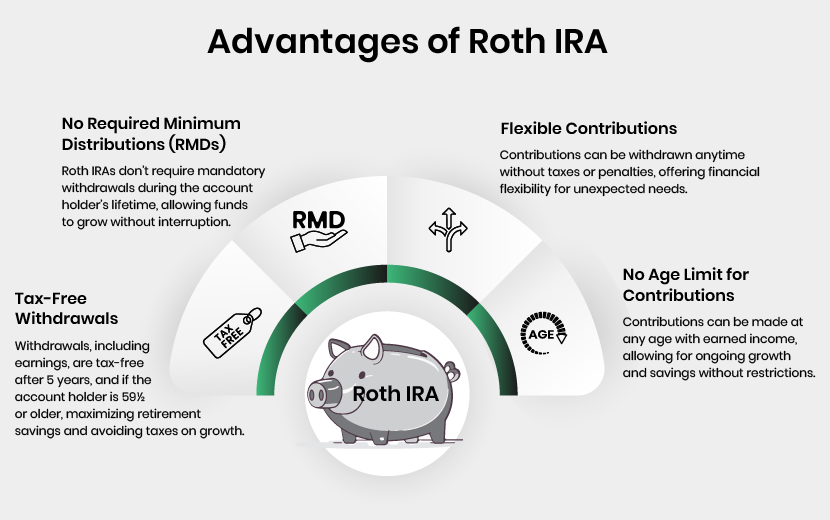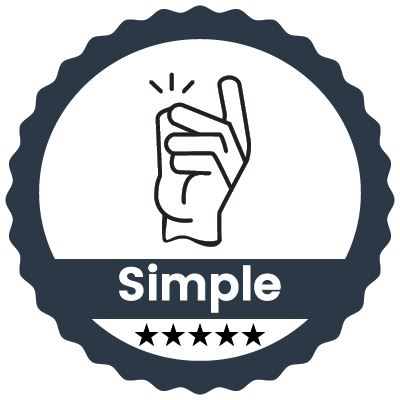- What is a Roth IRA?
- Key Information Employers Should Communicate
- Advantages of Roth IRA
- Roth IRA Withdrawal Penalty
- Contribution Limits and Income Limits for Roth IRA
- Roth IRA vs Traditional IRA
- Roth IRA vs Other Retirement Plans
- How Employers Can Support Employees with Roth IRAs
- Best Practices for Employers
- Simplify Your Pay Stub Creation with SecurePayStubs
What is a Roth IRA?
A Roth IRA (Individual Retirement Account) is a tax-advantaged retirement savings account. Unlike traditional retirement accounts, Roth IRA contributions are made with after-tax dollars, meaning they are not tax-deductible in the year they are contributed. However, Roth IRAs offer tax-free growth and withdrawals under specific conditions, making them a valuable retirement savings option for employees.
Key Information Employers Should Communicate
As an employer, it’s crucial to provide comprehensive information about Roth IRAs to your employees. Understanding the advantages, withdrawal penalties, contribution limits, and income limits can help employees make well-informed retirement decisions.
Advantages of Roth IRA

Roth IRAs offer significant benefits that can enhance your employees' retirement plans. Here’s why Roth IRAs are valuable:
- Tax-Free Withdrawals: Qualified withdrawals, including earnings, are tax-free if the account has been open for at least 5 years and the account holder is at least 59½ years old. This feature helps employees maximize their retirement savings by avoiding taxes on their growth.
- No Required Minimum Distributions (RMDs): Roth IRAs do not require mandatory withdrawals during the account holder’s lifetime, allowing funds to grow uninterrupted.
- Flexible Contributions: Employees can withdraw their contributions (but not the earnings) at any time without facing taxes or penalties, providing financial flexibility for unexpected needs.
- No Age Limit for Contributions: Contributions can be made at any age as long as the employee has earned income, enabling continued growth and savings regardless of age.
Roth IRA Withdrawal Penalty
As an employer, it’s important to provide your employees with clear information about Roth IRA withdrawal penalties to help them plan their retirement effectively. Here’s what you should share:
- Early Withdrawal Penalties: Explain to your employees that earnings withdrawn before the account has been open for 5 years or before they reach age 59½ may incur a 10% penalty and income taxes. Helping employees understand these penalties can guide them in planning their withdrawals and avoiding unexpected costs.
- Non-Qualified Withdrawals: Inform employees that to avoid penalties and taxes, withdrawals must meet the requirements of qualified distributions. Exceptions to penalties include withdrawals for first-time home purchases, qualified education expenses, or substantial medical expenses. Knowing these exceptions can provide employees with options for accessing funds if needed.
Contribution Limits and Income Limits for Roth IRA
As an employer, it's important to ensure your employees are fully aware of the Roth IRA contribution limits and Roth IRA income limits to help them make the most of their retirement savings:
- Contribution Limits: For 2024, the Roth IRA contribution limits allow employees under 50 to contribute up to $7,000. Those aged 50 or older can contribute up to $8,000. Sharing this information with your employees can help them plan their contributions effectively and take full advantage of their Roth IRA benefits.
- Income Limits for Contributions: Roth IRA income limits can impact eligibility for contributions. Employees who exceed these limits might consider alternative methods, such as backdoor Roth IRA contributions, to benefit from the advantages of Roth IRA. Providing resources or directing employees to financial advisors can help them explore these options.
Roth IRA vs Traditional IRA
To help employees understand the differences between Roth IRA and Traditional IRA, here’s a comparison of key features:
| Feature | Traditional IRA | Roth IRA |
|---|---|---|
| Eligibility for Contribution | Employees can contribute if they (or their spouse) have taxable compensation. Prior to Jan. 1, 2020, contributions were not allowed if age 70½ or older. | Employees can contribute at any age if they (or their spouse) have taxable compensation and their modified adjusted gross income is below certain limits. |
| Contribution Deductibility | Contributions may be tax-deductible based on income and other factors. | Contributions are not deductible. |
| Contribution Limits | For 2024: $7,000 ($8,000 if age 50 or older) or taxable compensation, whichever is less. | Same limits as Traditional IRA. |
| Contribution Deadline | Contributions can be made up until the tax return filing deadline (excluding extensions). For example, 2023 contributions are due by April 15, 2024 | Same as Traditional IRA. |
| Withdrawal Flexibility | Withdrawals can be made anytime. | Withdrawals can be made anytime. |
| Required Minimum Distributions (RMDs) | Must begin by April 1 following the year turning 72 (70½ if turned 70½ before Jan. 1, 2020) and by December 31 of subsequent years. | No RMDs required if the account holder is the original owner. |
| Taxation on Withdrawals | Withdrawals of deductible contributions and earnings are taxed. Early withdrawals (before age 59½) may incur a 10% penalty unless an exception applies. | Qualified distributions are tax-free. Non-qualified withdrawals may be taxed, and early withdrawals (before age 59½) may incur a 10% penalty unless an exception applies. |
Roth IRA vs Other Retirement Plans
Roth IRA vs 401(k)
Educate employees on the differences between Roth IRAs and employer-sponsored 401(k) plans. Understanding these differences can help employees make informed decisions based on their financial situation and retirement goals.
Contribution Limits
Roth IRA contributions are separate from 401(k) contributions. Educate employees on how they can leverage both accounts to maximize their retirement savings.
How Employers Can Support Employees with Roth IRAs
- Educate Employees: Provide resources and educational materials about what is a Roth IRA, its benefits, and potential Roth IRA withdrawal penalties. This helps employees make informed decisions regarding their retirement savings.
- Include Roth IRA Information in Benefits Packages: Add Roth IRA educational resources to your benefits offerings to assist employees in understanding and utilizing these accounts effectively.
- Partner with Financial Advisors: Collaborate with financial advisors to offer personalized guidance on Roth IRAs, including strategies to avoid penalties and maximize benefits.
- Provide Retirement Planning Tools: Offer calculators and planning tools to help employees estimate potential growth and understand the impact of their contributions and withdrawals.
Best Practices for Employers
- Encourage Early and Consistent Contributions: Promote the importance of starting Roth IRA contributions early to leverage tax-free growth and minimize penalties.
- Promote Comprehensive Retirement Planning: Advise employees on diversifying their retirement savings with both Roth IRAs and employer-sponsored plans to build a robust retirement portfolio.
- Stay Updated on Regulations: Keep informed about changes in Roth IRA laws and regulations to offer accurate and current guidance to employees.
Simplify Your Pay Stub Creation with SecurePayStubs
Unlock the ease of generating accurate and reliable pay stubs with SecurePayStubs. Perfect for employers and individuals alike, our tool is designed to streamline your pay stub process.
Here’s how SecurePayStubs benefits you
- Create Accurate Pay Stubs: Effortlessly generate detailed, precise pay stubs for all your needs.
- Ensure Compliance: Stay compliant with tax regulations and easily manage earnings and deductions.
Ready to make pay stub creation a breeze? Get Started with SecurePayStubs Today and enjoy the ultimate accuracy and convenience!
This article has been updated from its original publication date of September 19, 2024.



